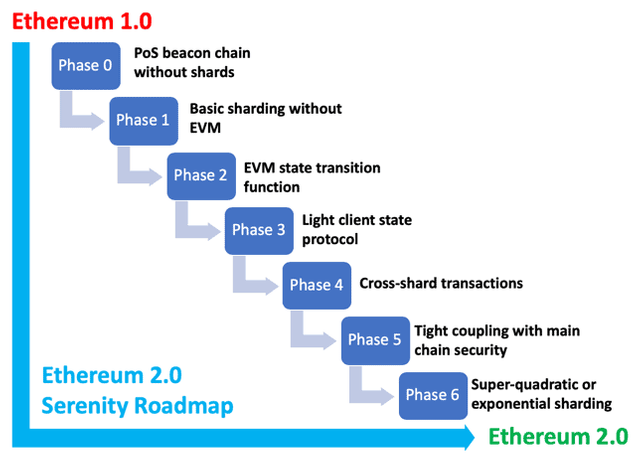Ethereum is a permissionless, non-hierarchical network of computers (nodes) which build and come to consensus on an ever-growing series of "blocks", or batches of transactions, known as the blockchain.
----- Each block contains an identifier of the block that it must immediately follow in the chain if it is to be considered valid.
Ethereum is growing everyday and new development has started happening so the future of ethereum is secure and save and everybody money is save, and some of the this development are.
Ethereum co-founder Vitalik Buterin published a plan on Monday for the first hard fork of the new Ethereum 2.0 Beacon Chain, tentatively named HF1.
The hard fork would allow the developers to introduce several key upgrades to the recently launched Beacon Chain, which would also serve as a useful test for deeper changes in the future.
---- The biggest practical change is the support for light clients — nodes that would have minimal resource requirements and could run on mobile devices. This would allow for “trust-minimized wallets” that are able to verify the blockchain on their own instead of relying on external service providers.
--- Light client support is introduced through specials purpose committees,” groups of validators that are randomly assigned to create special signatures that make it easier to determine the correct version of the chain.
Other improvements include fixes to fork choice rules, where developers identified several instances of the protocol being potentially vulnerable to reorganization attacks. The issues are subtle and require precise timing, but they could have allowed malicious actors to exploit the network while controlling a small portion of validators. These weaknesses were known before launch but were discovered too late to be fixed in time, [ Buterin]
---- In terms of practical changes, the hard fork aims to overhaul how the slashing and inactivity leakage mechanics work. Currently, stakers on Etherum2 may lose a portion of their capital either due to being inactive or by attempting to support a minority fork of the chain, which is punished with slashing.
---- Inactivity leakage was sometimes considered a deterrent to home staking, due to being penalized for force major issues like a patchy internet connection or blackouts. While the system was set up to be very lenient, the team is now further tweaking the mechanism to make life simpler for Stakers with unstable connections. The leak is set to become quadratic, meaning that there will be a significant difference between intermittent and continuous inactivity. For a rough example of the magnitude, a staker who experienced 10 outages for a six minutes each, totaling one hour, would lose 10 times less than another staker who simply disconnected their machine for one continuous hour.
--- Inactivity leaks will also end gradually instead of immediately, which ensures that offline nodes will keep losing value until the network is well above the necessary threshold for security.
---- While some of the changes make the system more lenient for honest mistakes, the team is changing some parameters to introduce harsher monetary penalties for bad behavior. This is aimed to “weaken the training wheels” of the system.
---- It is unclear when the hard fork will be performed, with development and review still required for some of the details of the proposal. In the meantime, the Ethereum developers are coming up with a naming convention for HF1 and future hard forks.
And the Chinese are moving fast. Chinese GPU miners reportedly bulk buying Nvidia laptops to mine Ether
[Helen Partz].
[https://cointelegraph.com/news/ethereum-2-0-set-to-undergo-first-hard-fork-upgrade]

This is hope for everyone not to fear.
--- As the Etherum platform grows, it will change the way we do business and transaction on a daily basis, we want to give you the opportunity to start using ethereum now . Thanks